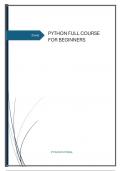Class notes
PYTHON TUTORIAL - PYTHON FULL COURSE FOR BEGINNERS
- Course
- Institution
Python is a popular programming language. It was created by Guido van Rossum, and released in 1991. It is used for: web development (server-side), software development, mathematics, system scripting.
[Show more]



